Zachary Huang, Michigan State University
Citation: Huang, Z.Y. 2014. Michigan spring flowers: winter aconite. BeetheBest Blog, http://bees.msu.edu/2014/winter-aconite/. Accessed on {date of your visit}.
Published April 6, 2014
Revised April 8, 2014
Well, spring is finally here in Michigan, about 1 month later than some years (and I have old photos to prove this). Winter aconite (Eranthis hyemalis) belongs to the “buttercup” family Ranunculaceae. Its name comes from its early blooming time (winter) and similarity to the true aconite (Aconitum). However, Aconitum is poisonous while Eranthis is not. This plant was native to Europe and Asia but has be become naturalized in North America.
I have always observed honey bees foraging on this flower when the weather is warm enough. The plant will bloom before crocus which is also an early flower in Michigan, which in turn blooms before maple and pussy willow. I think winter aconite will bloom slightly ahead of skunk cabbage and snowdrops. Witch hazel might bloom around the same time but I have seen honey bees foraging on witch hazel only one year.
Judging their behavior on the flowers, I think honey bees are obtaining both pollen and nectar. After a long winter, honey bees are anxious to foraging on these early flowers. I am thinking to seed some winter aconite this year when seeds are available, perhaps after a month also.
A recent study (Rysiak and Zuraw, 2011) says that the nectar concentration from this flower is quite high ( 61-78%, with a mean of 72%) but the total weight of nectar is only 1.23 mg per flower, yielding an average of 0.88 mg of sugar. I calculated a single bee takes 11 mg of sugar per 24 hrs to survive, so that worker will need to visit many flowers to contribute to the colony weight gain. The honey crop can carry a maximum of 50 microliter of liquid, but the average load is about 25 mg by weight.
A flower without bees to show the complete structure. The yellow, tube-like structures are nectaries. The nectaries actually formed from the petals. Now the petal-like structures are actually sepals! How confusing…
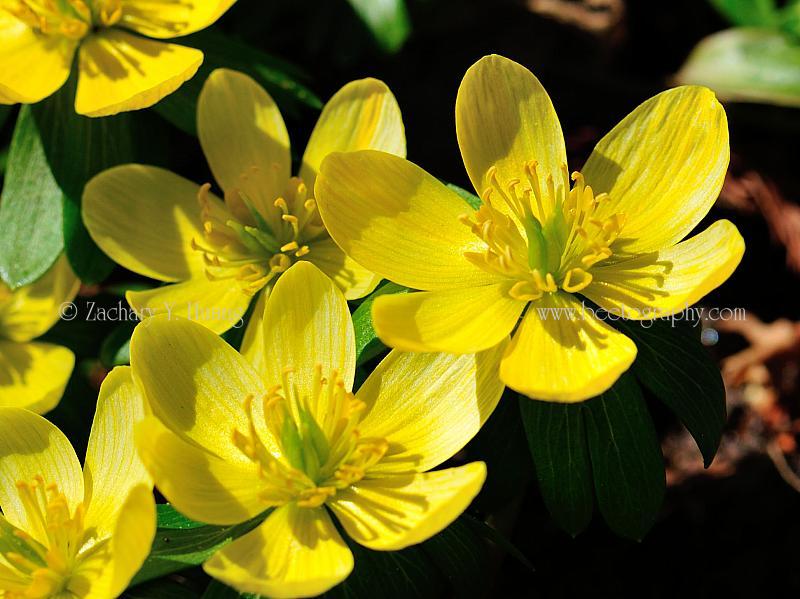
The first time I checked the patch of winter aconite at the MSU Beal Botanical Garden (all flowers below are shot there) this year, it was March 21, 2014. Winter aconite just started blooming but it was still to cold for bees to forage that day. This was from my android cell phone.
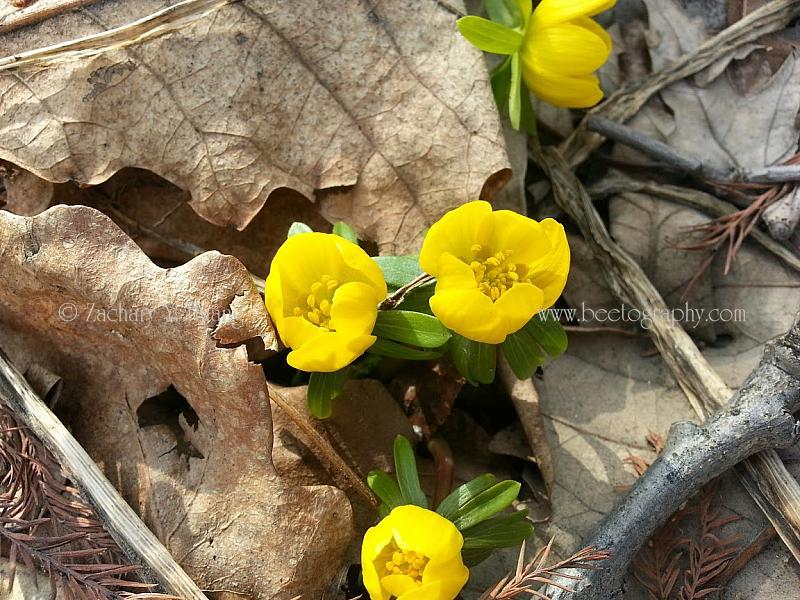
On March 31, 2014, 2nd trip to the garden. I only got one good picture of bees on winter aconite, having spent most of time trying to get an ultraviolet photo. I am teaching the “Macro Photography” course and took students there to shoot bugs on flowers. But only winter aconite and snowdrops were blooming.   We saw only honey bees and flies working on this flower. Most likely this is the first time in 2014 Michigan bees had a chance to forage on flowers. Photo from Nikon D700.
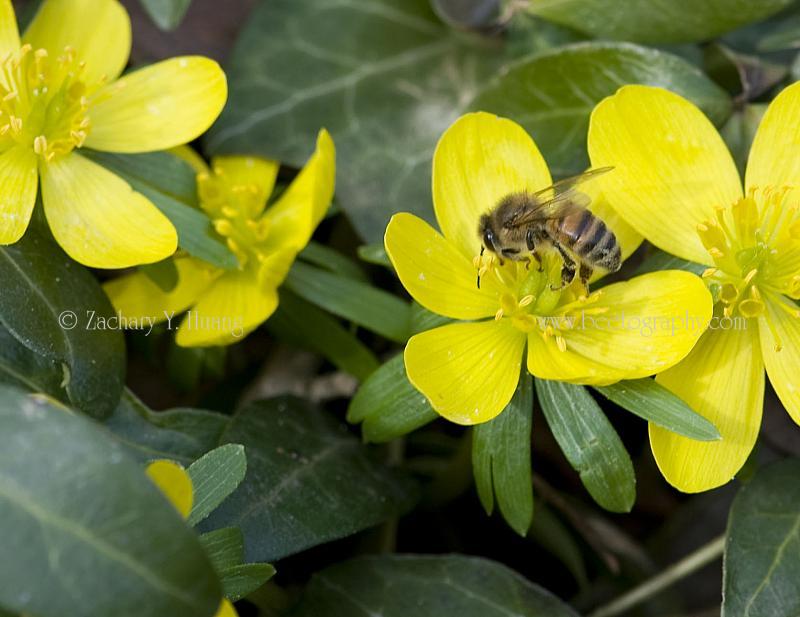
In 2010, it was March 17 that winter aconite was having a peak bloom. Photo from Nikon D700.

This bee seems to be probing for nectar, but she also has pollen on her pollen baskets (visible on her right leg).
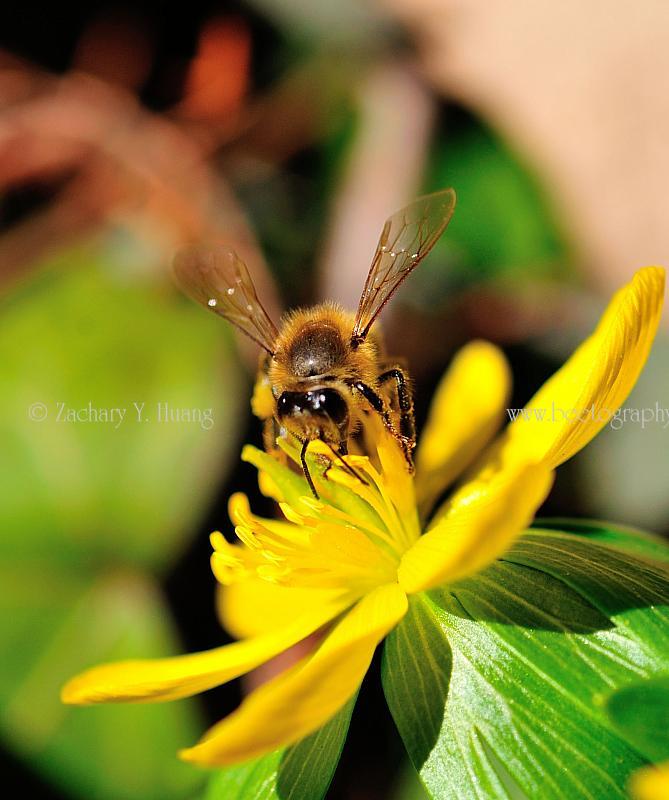
I suspect the four greenish structure in the center are stigmas.
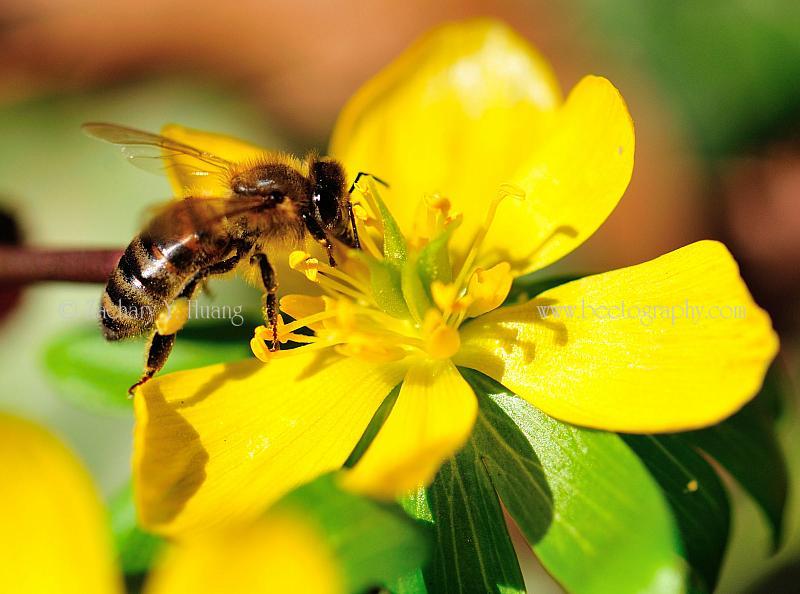
What a beautiful field of gold! [reminded me the song “Fields of gold” but this is not barley :)]. Shot at F2.8 to show you the depth of field. You can see three bees along the focused area.
Getting a bit closer to show one bee foraging.
March 13, 2007. Yet earlier than 2010. Photo from Nikon D80.
This is a solitary bee, not a honey bee. I do not know if it is an andrenid or another bee. April 5, 2005. from a Nikon D70, my first digital SLR.

Now a honey bee, the pollen is clearly visible on her basket. That year, there must be a really cold spell after the flowers bloomed. I can see the leaves were the wrong color (killed by very cold weather?).
March 6, 2002. Even earlier. This was from my Nikon Coolpix 990, which is a point and shoot camera, 3.2 megapix. I remember one year winter aconite was blooming in February, but I do not remember which year; and for some reason I do not find the photos of winter aconites.
That day I saw flies and ants on flowers, but no bees.
Going back even further, I have one photo of winter aconite by my very first digital camera, Olympus D450Z (1.3 megapix, paid $500 in 1999!). March 8, 2000.
Finally, what does winter aconite look like under ultraviolet (UV)? Shown left is an image with visible light (by Nikon D70 from borrowed from Bernice DeMarco — Thank you Bernice!). Nikon D70 has some sensitivity to UV, even when not modified. Except D70 and D40, all other cameras have to have an internal filter removed so it can receive enough UV. Still one needs a special lens that has enough UV transmission — most modern lens have coatings blocking UV. With the D70, the same lens and a special filter that blocks visible light + infrared, but passes UV, I got the photo on the right. Notice the center with pollen is UV black. In addition, the back side of petals are also black (the center of the photo has a flower I picked to show the back side) with a ring of yellow only. Honey bees probably see a combined view of both (since they can see visible light except red!).
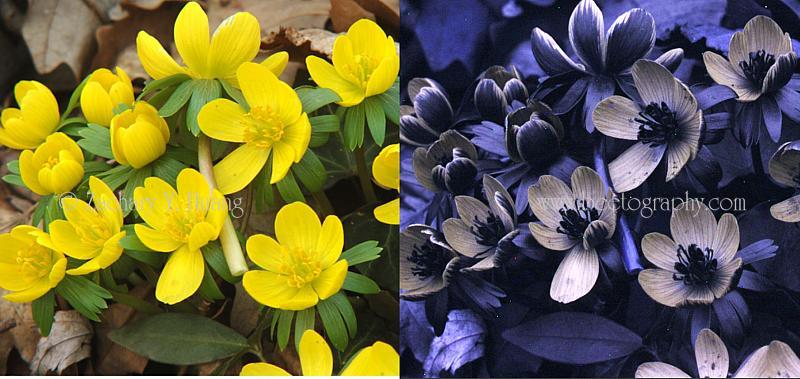
For more photos of winter aconite, please visit here
For photos under UV, please visit here.
Thank you for your attention, Zachary.
References:
Rysiak, K, B. Beata. 2011. Biology of flowering of winter aconite (Eranthis hyemalis (L.) Salib.). Acta Agrobotanica 64: 25-32
Wikipedia. 2014. Eranthis. http://en.wikipedia.org/wiki/Eranthis. Accessed April 5, 2014.
WHEN is the time to collect seeds? I have been EVERYWHERE on line to find this info. I had collected seed from a local, incredible garden and hiking area 9 years ago; the seeds (and the head-gardener there encouraged me to collect), literally poured into my hands from the seed heads. I broadcast the seeds where the gardener suggested [shady-ish, undisturbed areas] and forgot about them for 3 years, when suddenly BOOM there they were! I just don’t know what TIME of year is best to collect, and I’m getting nowhere on-line getting an answer (I know they have to grown and establish over a 2-3 year period), but I keep missing out on the harvesting!).
Help!
Thanks
SSK
Sammy, I do not either, but perhaps in another 2 weeks time? If too late they will be all shed. If too early they are not mature. Zachary